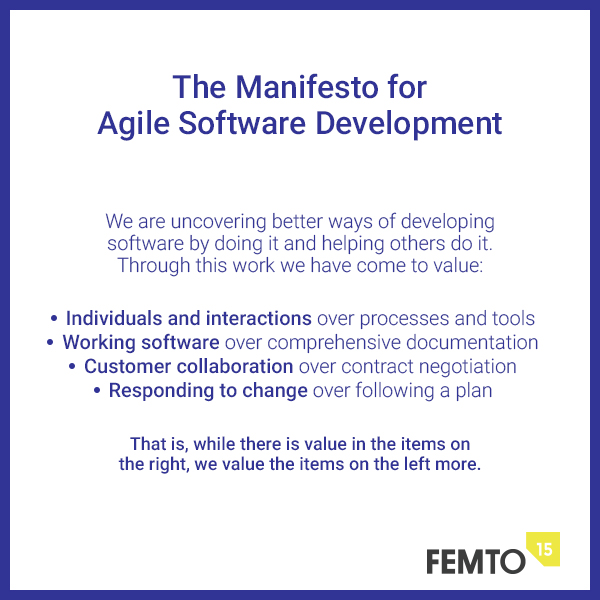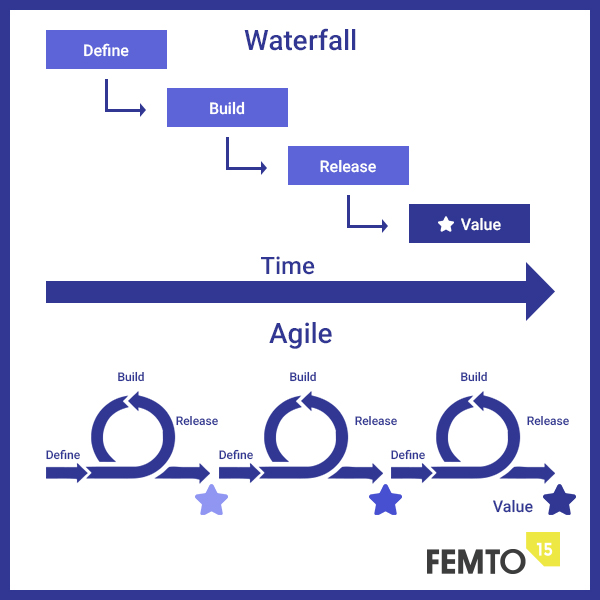
Better Web Development and Project Management With Agile
By Femto15 Team - September 24, 2019At the early 21st century, a group of software professionals decided that (according to their long experience in the field) the process of building a home is different from building software products. Thus, the workflow of each project should differ, which means the management, principles, communication ways, and other project management blocks.
The pain points that led to Agile was basically around the rapid changes that happen while developing software projects. The nature of software applications couldn't stand to the strict waterfall approach.
They set some values and principles that should manage software development projects and uncovered their Manifesto which has been adapted since then by various organizations (Femto15 is one of them) as a better way to perform and manage software projects that didn’t really fit the old Waterfall technique.

CONTENT
- What is Agile?
- Why is Agile Project management better than Waterfall?
- Why is Agile best for Web Development Projects?
- How to apply Agile principles teams and projects?
What is Agile?
It’s a Project Management Approach that works best in managing software projects. Agile is a set of values and principles, that means, it’s a way of thinking more than a group of tools.
When you apply those principles in a way that meets the values of your organization, you get the best out of Agile management. But if you only think of Agile as some tools, models, stand up meetings or whatever is said about it, you are not close to the core concept of Agile.
Why is Agile project management better than Waterfall?
Usually, people define Agile in contrast to Waterfall to show the differences and clarify the picture for those who are familiar with the Waterfall. This method also presents the pros of Agile VS the cons of Waterfall in the software world.
We would prefer to mention the specifications of Agile project management, and you will get the picture at the end.
Flexibi lity
“Responding to change over following a plan” is one of the four Agile values which means that planning for the project is an important thing, but the plan is a flexible thing which we can change for a better output.
Iterative
In contrast to the linear Waterfall approach which is sequential, Agile is an iterative way of managing. Projects are broken down into small iterations, each iteration represents a minimum project which is part of the final one.
Time-boxed
On Agile projects, it’s more about time than features. Unlike traditional approaches, time and cost are fixed at Agile management, while features are flexible to change, remove, and even add. A time-box is the time needed to complete an iteration.
| Traditional | Agile | |
| Fixed | Features | Time & Cost |
| Variable | Time & Cost | Features |
Value-driven
Some features represent the core of the software product; those are the most needed by users. Thus, not all features are of the same value. That's why in Agile the priority of features drive the planning of iterations. Which means features with a higher value will have higher priority when developing, it will be on the first iterations.
Faster value
On Agile management, customers may get a release after a few weeks. The release may only contain some basic features, but it's still a piece of the final value.
Let’s say it’s a website, the release may have the home and the login pages only. Customers will check it out, give feedback, change things, and the next iteration goes on. That’s one of the basic differences between Waterfall and Agile.

Frequent feedback
As the approach supports early and often releases, customers will give feedback after each release. That helps
Lower risk
The risk of a final output that doesn’t match customer’s expectations or end user’s needs minimizes in Agile projects as you don’t deliver a big end output; instead, the process of analyzing features and getting feedback was an ongoing process over the overall project.
Collaborative
“Customer collaboration over contract negotiation” is another piece of Agile values. That means customers participate in each stage of development not only at the beginning. They are also continuously updated with the progress of the project.
Deliverables don’t flow from one department to the other, and that’s it. Rather, each iteration is like a new project with new meetings with customers to plan the next one. It’s an ongoing process.
Shared Ownership and Responsibility
Everybody owns the project not only the project manager. Stakeholders, developers, testers, designers, and every member owns the project and is responsible for its success or failure. They all take responsibility for planning the project, taking decisions, and consuming changes. Everyone gives feedback, make changes, and collaborate on each iteration of the project.
Communications
The communication between team members on Agile projects is quite easy, fast, and straightforward. It’s not strict to papers and long meetings; rather, it can be weekly or daily quick meetings where everybody
Small teams
A process with the previous specifications can’t be applied in large teams as it would be risky, rather it’s best for small teams and startups.
Why Agile is best for web development projects?
For different reasons, we claim that Agile is the best project management approach for web development projects; some of these reasons are:
- Web development world rapidly changes, there are new features and trends every day, and all customers want to keep up with the pace. The flexibility of Agile management gives customers space to change their needs while developing rather than making all the decisions at the first stage and keep strict to the written contract.
- The nature of web development makes it much easier to split the project into small iterations with minimum releases as you can consider each page of the website a separate project.
- Most of the time, customers would have a different image on mind about the final output. They would want to change some requirements after they see the real thing, add more features after users’ feedback, or get rid of others if they were told it will consume time to achieve and may never be used.
- The web world is basically about people's participation and feedback. That’s why customers’ and end user’s opinion is a fatal thing for web development. It’s not optional to neglect it, but you need to use it; which is harder on the waterfall approach.
How to apply Agile principles teams and projects?
As mentioned above, Agile is some values and principles that can be embodied into some mythologies or frameworks such as Scrum, Kanban, Extreme Programming (XP), Feature-driven
These methodologies specify the roles of managers, the methods to perform Agile principles, and the techniques of the overall process.
The general role in Agile management is that management is not about controlling people but leading them to do the best.
Final words
Though Agile may seem like a savior approach for any software project manager, it also has some challenges and risks. Managing these challenges is part of successful Agile management. After all, you should seek the best approach that would work best for your organization, team, and work environment.
ABOUT AUTHOR
Femto15 Team


you may also like
0 comments